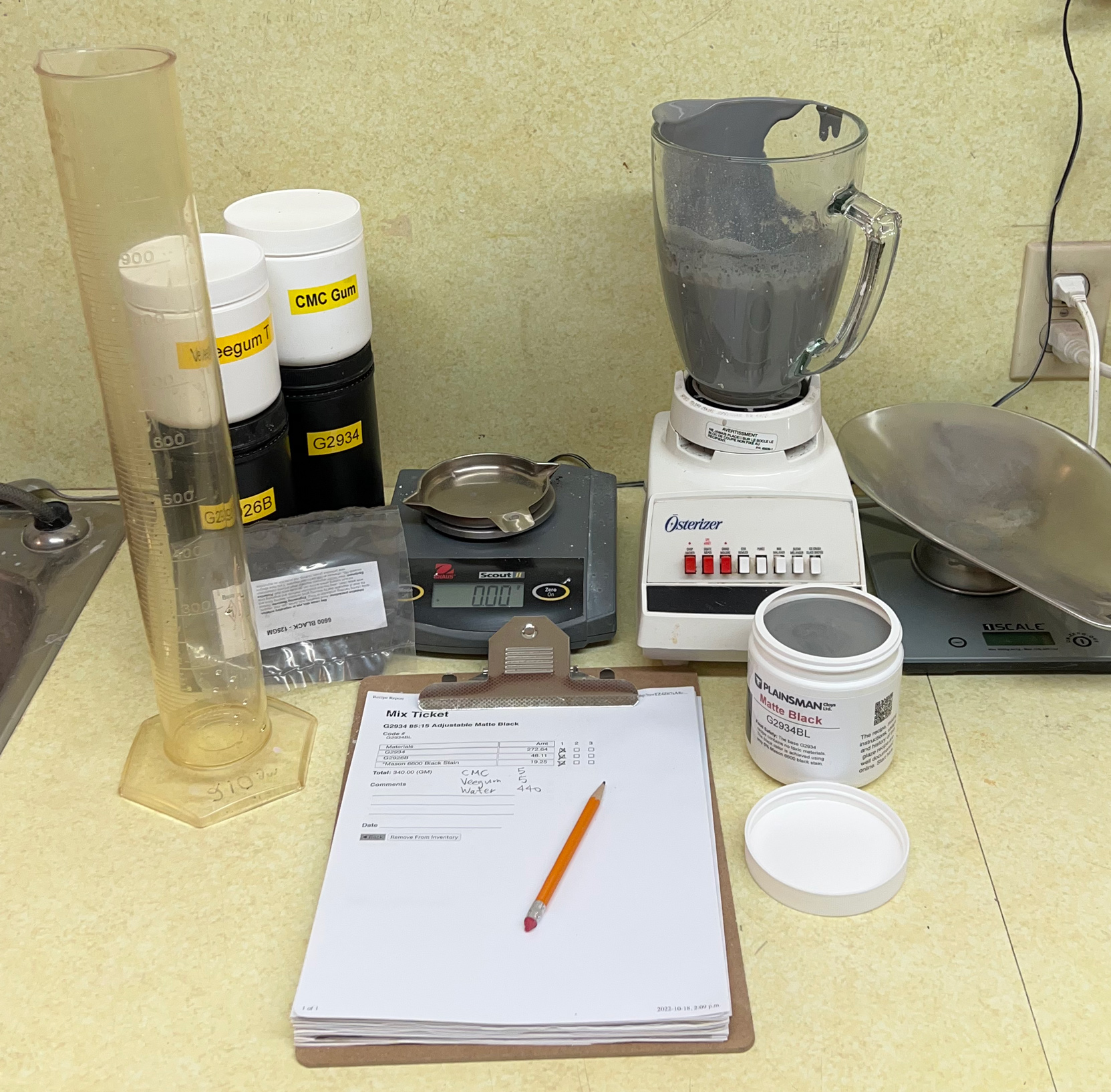| Monthly Tech-Tip | No tracking! No ads! |
Here’s how we make a base brushing engobe
This brushing engobe is thick and gooey (because it contains CMC gum), so it is practically impossible to sieve. Our regular propeller mixer is not able to break up the tiny agglomerates of New Zealand kaolin. But 30 seconds of blender mixing makes it as smooth as silk. To make this liter of brushing engobe we use 800g of powder and 10g of CMC gum in 800g of water. Because of the very high clay content this does not require Veegum to gel it. The CMC gum greatly improves the brushing properties. It also thins the slurry enough to enable its lower-than-normal water content, making it more suitable for painting onto leather-hard ware, minimizing the number of coats needed.
Related Pictures
This is how New Zealand kaolin powder agglomerates

This picture has its own page with more detail, click here to see it.
These lumps do not break down easily in a dry mixer, even when with other materials (like silica and feldspar). And they just bounce around on a vibrating screen. That means that without some sort of finishing device in the dry material feed stream is needed to break down these lumps before the pugmill.
Here is my setup to make brushing glazes and underglazes by-the-jar

This picture has its own page with more detail, click here to see it.
Although I promote DIY dipping glazes, you can also make DIY brushing glazes. Let's make a low SG version of G2934BL. Weigh out a 340g batch of dipping glaze powder. Include 5g Veegum (to gel the slurry to enable more than normal water) and 5g CMC gum (to slow drying and impart brushing properties). Measure 440g of water initially (adjusting later if needed). Shake-mix all the powder in a plastic bag. Pour it into the water, which is blender mixing on low speed, and finish with 20 seconds on high speed. This just fills a 500ml jar. In subsequent batches, I adjust the Veegum for more or less gel, the CMC for slower or faster drying and the water amount for thicker or thinner painted layers. Later I also assess whether the CMC gum is being degraded by microbial attack - often evident if the slurry thins and loses its gel. Dipping glaze recipes can and do respond differently to the gums. Those having little clay content work well (e.g. reactive and crystalline glazes). If bentonite is present it is often best to leave it out. Recipes having high percentages of ball clay or kaolin might work best with less Veegum. Keeping good notes (with pictures) is essential to reach the objective here: Good brushing properties. We always use code-numbering (in our group account at Insight-live.com) and write those on the jars and test pieces. This is so worthwhile doing that I make quality custom labels for each jar!
Brushing engobe fitted to this white porcelain turns it black

This picture has its own page with more detail, click here to see it.
The L3954F engobe is tuned to have the same degree of vitrification as this porcelain (P300). I made a pint of a brushing version of it by mixing a 500-gram batch with 75g of Laguna Gum Solution and 280g water (it does not require VeeGum because we want a lower specific gravity than would be typical for a brushing glaze). Mixing in a kitchen blender gets all the lumps out and makes it paint beautifully onto leather-hard ware. One coat covers. This enables presenting this normally white burning body as a black porcelain to match the glaze. I get so excited about these that I make my own labels for single-jar brushing glaze and underglaze tests. They clearly show the code number, we assign these, for the project, in our insight-live account. Subsequently, the piece was bisque-fired, black-glazed, and fired at cone 6. The band painted on the base, which I did as a fix-up for a few tiny white bare spots, demonstrates something unexpected about this homemade engobe: It paints well on a vitrified surface, dries there without cracking and even fires there without flaking off.
Videos
Links
| Glossary |
Blender Mixing
An ordinary kitchen blender does a better job of mixing a ceramic slurry than any industrial machine. It even reduces clay particle size and hyper ages it. |
| Glossary |
Agglomeration
The fine mineral, oxide and clay particles used in ceramics often aglommerate during storage or even in the latter stages of production. These must be broken down later. |
| Glossary |
Engobe
Engobes are high-clay slurries that are applied to leather hard or dry ceramics. They fire opaque and are used for functional or decorative purposes. They are formulated to match the firing shrinkage and thermal expansion of the body. |
Got a Question?
Buy me a coffee and we can talk

https://digitalfire.com, All Rights Reserved
Privacy Policy

